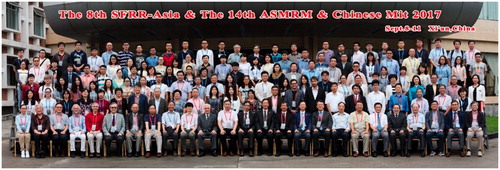The 8th Biennial Meeting of the Society for Free Radical Research - Asia (8th SFRR-Asia) and the 14th Conference of the Asian Society of Mitochondrial Research and Medicine (14th ASMRM) in conjunction with 2017 Chinese Mitochondrial Research Association (Chinese Mit 2017) were held in Xi’an, China from September 8 to 11 2017 with the theme of “Cross-talk between free radicals and mitochondria in health and disease”.
As we all know, Harman proposed the “Free Radical Theory of Aging” in 1956 [Citation1] and also the “Mitochondrial clock” in 1972 [Citation2]. However, for a long time, scientists have considered that free radicals/reactive oxygen species (ROS) are bad guys and tried to find various antioxidants to both scavenge ROS, and/or inhibit their formation. However, there are multiple lines of compelling evidence supporting that free radicals/ROS are also important signaling molecules [Citation3,Citation4], and that mitochondrial and cytoplasmic ROS can even have opposing effects [Citation5]. In addition, it is now well established that “antioxidants” are not necessarily beneficial, and can be harmful under certain circumstances, such as high levels of beta-carotene in people who smoke [Citation6,Citation7]. Meanwhile, there is increasing evidence to suggest that mitochondrial dysfunction can contribute to aging and many diseases, and that targeting mitochondrial metabolism may be an effective measure to delay aging and prevent (or even treat) some oxidative damage-related diseases [Citation8–12]. Therefore, it is now becoming increasingly evident that free radicals/ROS and mitochondria are closely related, and the cross talk between free radicals/ROS and mitochondria needs to be better elucidated.
It is important to point out that Prof. Hideyuki Majima from Kagoshima University, Japan, has made an important contribution in this respect by organizing the first combined Biennial Meeting of SFRR-Asia & the Conference of the ASMRM in 2011. Therefore, the 8th Biennial Meeting of SFRR-Asia & the 14th Conference of the ASMRM was the second attempt, within Asia, to encourage scientists in the fields of free radical and mitochondria to collaborate on the cross talk between free radical/ROS and mitochondria. This meeting was co-organized by the Key Laboratory of Biomedical Information Engineering, Ministry of Education, School of Life Science and Technology of Xi’an Jiaotong University, SFRR-Asia, ASMRM, Chinese Mitochondrial Research Society and Free Radical Biomedical Branch of Chinese Biophysical Society. In this meeting, Professor Jiankang Liu, Dean of School of Life Science and Technology of Xi’an Jiaotong University, served as the chairman, with the vice chairmen including Prof. Yang Liu from Institute of Chemistry, Chinese Academy of Sciences, Prof. Qingshan Liu from Zhongshan Medical University, Taiwan, China and Prof. Quan Chen from Institute of Zoology, Chinese Academy of Sciences. The presentations included two keynote speeches, 46 professional reports, and 88 posters. More than 200 researchers from America, Japan, Korea, and China got together and exchanged ideas and recent progress. Prof. Enrique Cadenas from the University of Southern California started with a great speech entitled “Insulin resistance in brain energy metabolism and inflammatory response”. From September 9 to 11 2017, many internationally renowned scholars in the field of free radicals and mitochondria have given excellent talks, including Shinya Toyokuni, Yasutoshi Koga, Young-Joon Surh, Jianjian Li, Yun-Soo Bae, Hideyuki Majima, Shusen Liu, Baolu Zhao, Yaohui Wei, Chongyi Zhao, Qingshan Liu, Quan Chen, Chang Chen, Guangjun Nie, Jinliang Xin, and others.
This conference was not only a summary of current research on free radicals and mitochondria in recent years, but also provided a high-level platform for exchange of ideas and collaborations among researchers not only from Asia but also from the rest of the world. The conference also showed the achievements and strength of Chinese scientists in the field of free radicals and mitochondria, and played an important role in promoting the international influence of Xi’an Jiaotong University’s life sciences.
This special issue is a collection of selected presentations (both original and review articles) from the participants. We hope that it will serve as a historical memory of the 8th SFRR-Asia & 14th ASMRM & Chinese Mit 2017 for all participants, in addition to the renowned Terracotta Warriors and Horses in Xi’an, and act as a bridge to connect researchers by stimulating enthusiasm and promoting collaborations and development of free radical/ROS and mitochondrial research not only in Asia, but also in the world.
References
- Harman D. Aging: a theory based on free radical and radiation chemistry. J Gerontol. 1956;11:298–300.
- Harman D. The biologic clock: the mitochondria? J Am Geriatr Soc. 1972;20:145–147.
- Shadel GS, Horvath TL. Mitochondrial ROS signaling in organismal homeostasis. Cell. 2015;163:560–569.
- Indo HP, Hawkins CL, Nakanishi I, et al. Role of mitochondrial reactive oxygen species in the activation of cellular signals, molecules, and function. Handb Exp Pharmacol. 2017;240:439–456.
- Schaar CE, Dues DJ, Spielbauer KK, et al. PLoS Genet. 2015;11:e1004972.
- Alpha-Tocopherol, Beta Carotene Cancer Prevention Study Group. The effect of vitamin E and beta carotene on the incidence of lung cancer and other cancers in male smokers. N Engl J Med. 1994;330:1029–1035.
- Tanvetyanon T, Bepler G. Beta-carotene in multivitamins and the possible risk of lung cancer among smokers versus former smokers: a meta-analysis and evaluation of national brands. Cancer. 2008;113:150–157.
- Ames BN, Shigenaga MK, Hagen TM. Mitochondrial decay in aging. Biochim Biophys Acta. 1995;1271:165–170.
- Liu J, Shen W, Zhao B, et al. Targeting mitochondrial biogenesis for preventing and treating insulin resistance in diabetes and obesity: hope from natural mitochondrial nutrients. Adv Drug Deliv Rev. 2009;61:1343–1352.
- Shigenaga MK, Hagen TM, Ames BN. Oxidative damage and mitochondrial decay in aging. Proc Natl Acad Sci USA. 1994;91:10771–10778.
- Liu J, Atamna H, Kuratsune H, et al. Delaying brain mitochondrial decay and aging with mitochondrial antioxidants and metabolites. Ann NY Acad Sci. 2002;959:133–166.
- Newgard CB, Sharpless NE. Coming of age: molecular drivers of aging and therapeutic opportunities. J Clin Invest. 2013;123:946–950.

